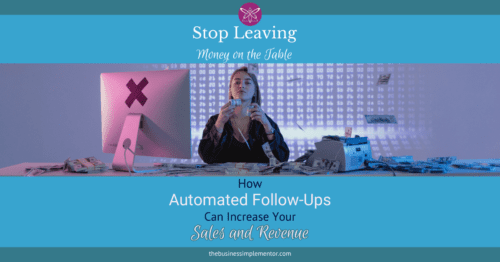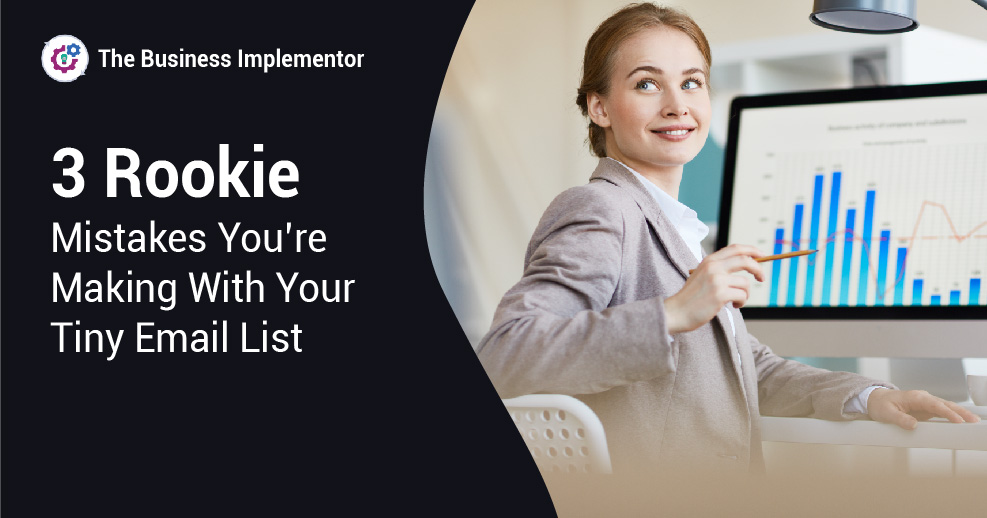As any smart business owner knows, the key to passive income is a well-established (and full) funnel. So of course you’ve optimised your opt-in pages and monetized your download pages and encourage more buyers through well-placed upsells and downsells.
But what about the follow-up? Do you contact customers about the products or services they didn’t buy? Do you encourage them to use the products they have purchased? Are you making sure they know about all your other wonderful programs?
If not, you’re missing the boat. But the good news is, this can be easily managed with just a bit of simple automation, and when done right, it will smoothly lead your customers from one purchase to the next, at the exact right time for them to take advantage of your best offers.
In today’s competitive business landscape, it’s more important than ever to build strong relationships with your customers. While acquiring new customers is important, retaining existing ones can be just as valuable, if not more so.
One effective way to encourage repeat purchases and build customer loyalty is through automated follow-ups. By staying in touch with customers after their initial purchase, you can keep your brand top-of-mind and make the next step a no-brainer for them to buy from you again.
In this article, we’ll explore the benefits of automated follow-ups, different types of follow-ups you can use, how to implement them, and provide examples of successful campaign.
Did you know that:
- A survey by Adobe found that returning customers account for 40% of online store revenue, even though they only make up 8% of website visitors.
- In a study by HubSpot, personalised email subject lines resulted in a 26% higher open rate compared to generic subject lines.
- According to a report by Experian, automated email campaigns have an average open rate of 45.7% and a click-through rate of 17.1%.
Does that spark a little motivation for you to think about all the ways you might be missing out on revenue. And it can all be automated so you are looking after your customers - literally while you sleep. Follow-ups are important for several reasons, particularly when it comes to building strong relationships with your customers and driving repeat purchases.
Here are some reasons why follow-ups are important:
- Encouraging customer loyalty: By following up with customers after their initial purchase, you show that you value their business and are committed to providing a positive customer experience. This can help build trust and loyalty over time.
- Keeping your brand top-of-mind: When you stay in touch with customers through follow-ups, you can keep your brand top-of-mind and increase the chances that they will think of you the next time they need a product or service that you offer.
- Providing additional value: Follow-ups can be an opportunity to provide additional value to customers by sharing helpful tips, offering promotions, or suggesting related products or services.
- Addressing customer concerns: Follow-ups can also be an opportunity to address any concerns or issues that customers may have had with their initial purchase. This can help prevent negative reviews or feedback and improve overall customer satisfaction.
- Driving repeat purchases: Ultimately, the goal of follow-ups is to encourage customers to make repeat purchases. By providing a positive customer experience and staying in touch with customers, you can increase the likelihood that they will choose to do business with you again in the future.
Overall, follow-ups are an important part of any customer retention strategy and can help businesses build strong, long-lasting relationships with their customers.
To start with here are the steps to following up, starting with segmenting your audience:
- Segment your audience: Before you start following up with customers, it’s important to segment your audience based on factors like their purchase history, preferences, and behaviour. This will help you tailor your follow-up messages to each group and increase their relevance and effectiveness.
- Determine your follow-up goals: What do you want to achieve with your follow-ups? Are you trying to encourage repeat purchases, gather feedback, or address customer concerns? Defining your goals upfront will help you create more targeted and effective follow-up messages.
- Choose your follow-up channels: There are many channels you can use to follow up with customers, including email, SMS, social media, and direct mail. Choose the channels that make the most sense for your audience and your goals.
- Create your follow-up messages: Your follow-up messages should be personalised, relevant, and provide value to the customer. Consider using dynamic content to customise your messages based on each customer’s preferences or behaviour.
- Automate your follow-ups: To save time and ensure consistency, it’s a good idea to automate your follow-up messages using an email marketing or automation platform. This will allow you to set up triggered messages based on customer behaviour, such as cart abandonment or post-purchase feedback requests.
- Monitor and analyse your results: Once your follow-ups are in place, it’s important to monitor and analyse their effectiveness over time. Look at metrics like open rates, click-through rates, and conversion rates to identify areas for improvement and optimise your follow-up campaigns.
By following these steps, you can create effective follow-up campaigns that help you build stronger relationships with your customers and drive repeat purchases.
You might be wondering how you would automate your follow-up. And you guessed it – technology can do this for you. Some systems are very sophisticated and you might be pretty intimidated by the things it can do.
But don’t let that put you off. You need to analyse what you need and then find a system that can do that. In fact, in your research, you may even learn about new and exciting ways that you can follow up with your customers.
But let's start with the difference between an autoresponder and a CRM.
An autoresponder and a CRM (customer relationship management) system are both tools that businesses can use to communicate with customers, but they serve different purposes.
An autoresponder is a tool that sends emails to people who have signed up. It sends messages that have already been written.
These pre-written messages can be used for welcome messages, reminding people about the things they put in their online cart but didn’t buy, or special offers. Autoresponders help businesses save time and keep in touch with their customers.
A CRM system helps businesses keep track of how they talk to customers. It stores data about customers and tracks what conversations happen between them. It can help businesses understand the customer’s needs and their wants much better. This lets the business give a better experience to their customers by personalising their communication with them.
Autoresponders and CRM systems are both ways to communicate with customers. But they have different jobs. Autoresponders help to do tasks automatically. CRM systems help manage customer relationships.
Here are some examples of how businesses might use an autoresponder and a CRM system:
Autoresponder example:
A real estate agent might use a CRM system to manage their interactions with potential buyers and sellers. They might store information about each client, including their contact details, budget, and preferences. They could use this information to personalise their communications with each client, sending targeted listings based on their preferences, and scheduling follow-up calls to keep them engaged throughout the home-buying process. They could also use the CRM system to track the progress of each lead and identify areas where they can improve their customer service.
Overall, both autoresponders and CRM systems can help businesses improve their customer communication and relationships, but they serve different functions and are designed to address different needs.
Which platforms are autoresponders and which are CRM?
There are many platforms available for both autoresponders and CRM systems, and some platforms offer both features in one integrated solution. Here are some examples of popular autoresponder and CRM platforms:
Autoresponder platforms:
- Mailchimp
- AWeber
- Constant Contact
- ConvertKit
- GetResponse
- ActiveCampaign
CRM platforms:
- Salesforce
- HubSpot
- Zoho CRM
- Pipedrive
- Insightly
- Freshsales
Integrated platforms (with both autoresponder and CRM features):
- Infusionsoft
- Ontraport
- Keap (formerly Infusionsoft)
- Drip
- ActiveCampaign (also offers CRM features)
- HubSpot (also offers email marketing features)
It’s important to note that the specific features and pricing of each platform can vary, so it’s a good idea to research and compare different options before choosing the one that’s right for your business. You might find some tools that are free to use. Check if these tools have any limitations before you use them. It might be better to pay for the tool if it will help you get successful results faster.
All of these tactics require that you know your audience and your products exceptionally well. Study your stats. Know your open and click rates. Pay attention to the promotions that work, as well as those that fall flat. With the information in hand, you’ll be better able to effectively segment your lists and make the most of all the parts of your funnel.








